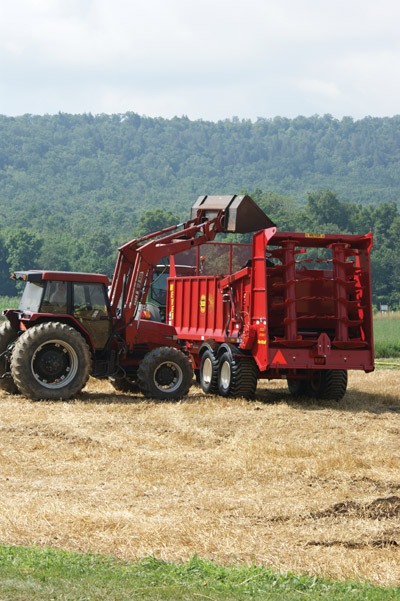
Features
Applications
Other
Manure land application focus of new grant
September 23, 2010 by manure manager
Returning nutrients and organic matter to Texas Panhandle soils is the
focus of a new federal grant awarded to the Texas Cattle Feeders
Association (TCFA) and the Texas AgriLife Extension Service, according
to project leaders.
Returning nutrients and organic matter to Texas Panhandle soils is the focus of a new federal grant awarded to the Texas Cattle Feeders Association (TCFA) and the Texas AgriLife Extension Service, according to project leaders.
 |
|
| A new federally funded project involving the Texas Cattle Feeders Association (TCFA) and the Texas AgriLife Extension Service informs manure and compost contractors, machinery operators and certified crop advisors of best management practices for land application of feed yard manure and compost. Photo by Margaret Land
|
Ben Weinheimer, TCFA vice president, said the three-year grant will help protect water quality in Panhandle streams and lakes. The project is designed to inform manure and compost contractors, machinery operators and certified crop advisors of best management practices for land application of feed yard manure and compost, Weinheimer said.
The project is funded through a Clean Water Act nonpoint source grant from the Texas State Soil and Water Conservation Board and the United States Environmental Protection Agency.
“This is a great opportunity for TCFA and our members to work with manure and compost haulers and landowners, who are an important part of the cattle feeding industry and help to ensure the beneficial use of manure on the land,” he said.
Weinheimer and his project co-leader, Dr. Brent Auvermann, AgriLife Extension agricultural engineer, will develop a training curriculum in English and Spanish, establish demonstration sites and host seminars and field days to help machinery operators.
The curriculum will teach them how to calibrate spreader equipment so manure and compost are applied to cropland, according to recommended rates based on crop requirements and water-quality protection, Auvermann said.
“In the Panhandle, we work our soils pretty hard to achieve the levels of crop production that we’re able to maintain year to year,” he said. “If it’s done right, manure application is a tremendous way to boost soil health and productivity, including holding onto that precious rainfall.”
Weinheimer said he and Brady Miller, TCFA regulatory manager, have spent a great deal of time and effort during the past decade monitoring the nitrogen and phosphorus levels in cropland owned and controlled by the association’s member feed yards.
“Through our Environmental Services Program, we have established a strong database of information on soils and manure, and assisted our members with managing nutrient applications,” Miller said. “It’s much easier to explain the importance of good environmental management practices when you have data and science in your hands.”
To document the importance of good land-application practices, Weinheimer and Auvermann have enlisted the help of an environmental soil scientist, Dr. Paul DeLaune, assistant professor with Texas AgriLife Research in Vernon.
“Dr. DeLaune brings a deep, research-based knowledge of soil fertility and soil chemistry to the project,” Auvermann said. “He has been working with nutrient management plans, phosphorus loading and water quality for over a decade.”
An international phosphorus workgroup has identified the lack of edge of field water quality monitoring data as the single largest scientific and management gap for addressing phosphorus loss, as well as pollutants from land use, said DeLaune.
“Due to the lack of data, many best management practices are not well quantified as to their impact on water quality,” he said. “This project will allow us to address these regional and national issues.”
Building on more than 10 years of collaborative environmental work on cattle feed yards, Weinheimer and Auvermann decided to focus the project’s monitoring activities in the Sweetwater Creek watershed in the eastern Panhandle, which was listed as “impaired.”
Auvermann said while the major monitoring efforts will take place in and around Wheeler County, the training programs will be delivered in all of the major cattle-feeding regions of the Panhandle and South Plains.
“We’re focusing our data collection in Sweetwater Creek, but the lessons we learn about land-application practices ought to apply just about anywhere in this part of Texas,” he said. “Given our climate and our declining aquifer, we’ve got to protect as many of our surface-water resources as we can.”
“We’re challenged with reducing bacteria to acceptable levels in over 270 creeks and rivers across this state. Fortunately, not many of these impaired water bodies are here in the Panhandle,” said Aubrey Russell, Texas State Soil and Water Conservation Board member, who represents 49 soil and water conservation districts across 51 counties in the Panhandle.
“By partnering with the Texas Cattle Feeders Association on this project, we believe we can protect the quality of our local water resources while providing needed educational programs to benefit all landowners who utilize feed yard manure and compost to fertilize their crops and pastures,” Russell said.
Weinheimer said cattle feeders have intently focused on environmental management at the feed yard level for many years, and this project is the next logical step in TCFA’s environmental management efforts.
“Our soils need what manure and compost have to offer,” he said. “We believe it’s the right time to focus on the important role that land-application contractors and landowners serve in the cattle-feeding industry.”